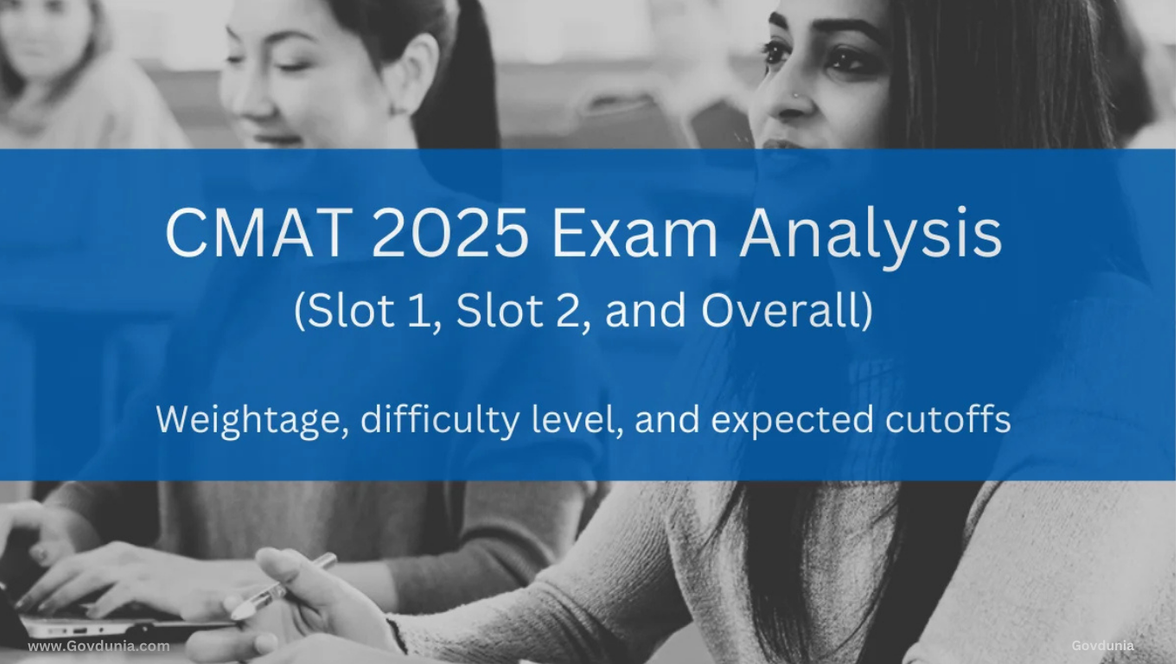The CMAT 2025 (Common Management Admission Test) concluded successfully on January 25, 2025, with two slots of examinations: Test times ran from 9:00 AM until 12:00 PM in Slot 1 and from 3:00 PM until 6:00 PM in Slot 2. The CMAT test maintained its position as an intermediate difficulty exam in this year’s sessions yet posed several subtle puzzles to students across different sections. Per expert assessment and candidate sentiment we have developed an extensive examination breakdown.
Official website of CMAT : CLICK HERE

Key Highlights of CMAT 2025 Exam
| Aspect | Details |
|---|---|
| Exam Date | January 25, 2025 |
| Exam Slots | Slot 1: 9:00 AM – 12:00 PMSlot 2: 3:00 PM – 6:00 PM |
| Overall Difficulty Level | Moderate |
| Number of Sections | 5 (Quantitative Techniques & Data Interpretation, Logical Reasoning, Language Comprehension, General Awareness, Innovation & Entrepreneurship) |
| Number of Questions | 100 (20 per section) |
| Marks per Question | 4 |
| Negative Marking | -1 for incorrect attempts |
| Duration | 3 Hours |
| Good Attempts (Overall) | 70-75 (with 80% accuracy) |
Section-Wise Analysis
The CMAT 2025 exam carried twenty questions per section which awarded four marks per question. A detailed breakdown of each section follows below which includes an assessment of challenge level together with recommended attempts and notional topics.

1. Quantitative Techniques & Data Interpretation
This section was relatively easy, with many questions based on Arithmetic. A few questions involved interpreting data from pie charts.
| Topics | Details | Number of Questions |
|---|---|---|
| Arithmetic | Time-Speed-Distance, Ratio-Proportion, Profit & Loss, SI-CI, Alligation & Mixtures | 10 |
| Geometry | Triangles | 1 |
| Modern Math | Probability | 2 |
| Numbers | Surds & Indices | 2 |
| Algebra | Quadratic Equations, Linear Equations | 2 |
| Data Interpretation | Pie Charts | 3 |
- Difficulty Level: Easy
- Good Attempts: 16-17 questions
2. Logical Reasoning
Logical Reasoning was another easy section, featuring 16 questions from Non-Verbal Reasoning and 4 from Verbal Reasoning.
Non-Verbal Reasoning Topics
| Topics | Number of Questions |
|---|---|
| Directions | 1 |
| Cubes | 2 |
| Counting Squares | 1 |
| Linear Arrangements | 1 |
| Family Tree | 1 |
| Clocks | 1 |
| Numerical Puzzle | 1 |
| Logical Venn Diagram | 1 |
| Set Theory | 1 |
| Number Series | 1 |
| Analogy (Word-Based) | 1 |
| Odd One Out | 1 |
| Alpha Numeric Series | 1 |
Verbal Reasoning Topics
| Topics | Number of Questions |
|---|---|
| Assertion Reason | 1 |
| Strong/Weak Arguments | 1 |
| Assumption | 1 |
| Conclusion | 1 |
- Difficulty Level: Easy
- Good Attempts: 15-16 questions
3. Language Comprehension
This section included 1 Reading Comprehension (RC) passage, with 2 associated questions. The remaining 18 questions were grammar-based, covering a wide range of topics such as Fill in the Blanks, Sentence Correction, and Parajumbles.
| Grammar Topics | Number of Questions |
|---|---|
| Fill in the Blanks (FIB) | 3 |
| Replace Underlined Phrase | 2 |
| Passive Voice | 1 |
| Cloze Passage | 3 |
| Parajumbles | 2 |
| Grammar (Articles, Nouns, etc.) | 5 |
- Difficulty Level: Easy
- Good Attempts: 15-16 questions
4. General Awareness
The General Awareness section was of moderate difficulty and focused entirely on Static GK. Topics ranged from Indian history and science to sports and international events.
| Topics | Details |
|---|---|
| Static GK | Indian Constitution, History, Science, Sports, Indian Culture, International Events |
- Difficulty Level: Moderate
- Good Attempts: 10-11 questions
5. Innovation and Entrepreneurship
This section was moderately challenging and covered a blend of conceptual and factual questions.
| Topics | Details |
|---|---|
| Startup Concepts | Bootstrapping, Startup Valuation |
| Entrepreneurship Types | Fabian Entrepreneur, Angel Investment |
| Business Concepts | Lean Startup, Feasibility Analysis |
| Business GK | Trademark |
- Difficulty Level: Moderate
- Good Attempts: 11-12 questions
Overall Difficulty Analysis
| Section | Number of Questions | Difficulty Level | Good Attempts |
|---|---|---|---|
| Quantitative Techniques & DI | 20 | Easy | 16-17 |
| Logical Reasoning | 20 | Easy | 15-16 |
| Language Comprehension | 20 | Easy | 15-16 |
| General Awareness | 20 | Moderate | 10-11 |
| Innovation & Entrepreneurship | 20 | Moderate | 11-12 |
| Total | 100 | Moderate | 70-75 |
Expected Cut-Offs for Top Colleges
| College | Expected Percentile | Cut-Off (Marks) |
|---|---|---|
| Management Development Institute, Gurgaon | 99+ | 260-280 |
| S.P. Jain Institute of Management, Mumbai | 98-99 | 250-270 |
| IMT Ghaziabad | 95-98 | 240-260 |
| K.J. Somaiya Institute, Mumbai | 92-95 | 220-240 |
| Christ University, Bangalore | 85-90 | 180-200 |
Key Takeaways for Aspirants
- The Quantitative Techniques and Logical Reasoning sections proved to be scoring opportunities for well-prepared candidates.
- Candidates should focus more on Static GK for General Awareness and strengthen their understanding of Entrepreneurship concepts for better results.
- A good strategy would be to aim for 70+ attempts with 80% accuracy to secure admission into top CMAT-accepting colleges.
Conclusion
The CMAT 2025 presented a level of difficulty which tested candidates moderately and did not heavily favor any particular section. Competent time management along with sustained preparation leads to successful test performance. These candidates should analyze present-year trends while designing future preparations to achieve higher scores in forthcoming CMAT exams.
For more such content join GOVDUNIA (click here)



